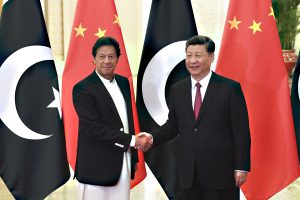At present, the future of Imran Khan’s government in Pakistan appears uncertain. As things stand now, the ruling coalition, led by Pakistan Tehreek-e-Insaf (PTI), has lost it majority and it is about to face a no-confidence vote. Should there be a change of government, however, there is unlikely to be a change in China-Pakistan ties. Pakistan’s relationship with China may have already become more stable than Pakistan’s democracy. Like a house that stands after lesser quakes even though it is cracked here or there, Chinese projects in Pakistan are too strong to be uprooted by the possible fall of Imran Khan’s government.
One reason is that Pakistan’s economy is staggering in its gait. Islamabad has little other choice but to turn to Beijing for more financial assistance. Pakistan used to be financially supported by two world powers, the U.S. and China, but relations with Washington have deteriorated to a point where such help is no longer possible. Some argue that a government change in Pakistan may lead to a reset of Washington-Islamabad ties, but that scenario is highly unlikely. Some factions in Pakistan may still want such a reset to happen, but with U.S. soldiers out of Afghanistan, Washington will have little interest in resuscitating its partnership with Islamabad. Apart from this, Pakistan still relies on International Monetary Fund (IMF) loans, and continues to ask for more. But negotiations around further IMF loans remain difficult, and Washington’s influence on the IMF is also a challenging factor for Islamabad. In these conditions, any future Pakistani government will probably be forced to continue borrowing more from China and a small group of other wealthy, friendly countries, such as Saudi Arabia.
Another consideration is that some Chinese projects have already brought positive change in Pakistan. It is true that net benefits of certain projects for Pakistan’s economy, as well as the financial burden of the loans taken from Chinese banks to complete them, have been the subject of many conversations in Pakistan. But the benefits are much clearer in the case of the energy sector. The first phase of the China-Pakistan Economic Corridor (CPEC) focused on power plants, probably because the planners intended to first create the energy needed to supply further projects (for instance, manufacturing units). But more generally, the construction of these plants, and their quick pace, has already reduced Pakistan’s electricity shortages.
Some of these projects were completed before the PTI came to power in 2018, including, among others, at least four coal power plants (one in Sahiwal, two in Karachi-Port Qasim, one in Thar), one hydroelectric power plant (in Thatta), one solar power plant (in Bahawalpur), and a group of wind farms in Jhimpir (aside from Chinese involvement in the construction of part of Chashma nuclear power plant, which, being earlier, is not counted among recent projects or as part of the CPEC). This kind of work has continued over the last four years under Khan’s tenure. In 2019, the construction of a coal power plant in Hub, Balochistan, was finished. In 2021, Karachi Nuclear Power Plant Unit-2 was completed. And 2022 should witness the completion of hydroelectric power plants in Suki Kinari and Karot.
Another reason a change in government may not change China-Pakistan relations is that earlier instances suggest that when a government change occurs in Pakistan, some Chinese projects may be stalled, or some financial focus may be shifted to other projects – to create benefits for other groups, companies or regions – but the strength of the Chinese presence as such, and the stability of Beijing-Islamabad relations will remain unaffected in the long run. This was what happened in the first year of Imran Khan’s tenure.
As soon as PTI came to power doubts were raised about the imbalance between how much certain projects benefit Pakistani companies and Chinese ones. The most common modus operandi is for China to offer loans for a project in Pakistan, but also task a Chinese company, or a few of them, with construction of the facilities for the project. These companies would often bring their own workers and materials, reducing the benefits for Pakistan and optimizing the benefits for China’s economy (such firms also often have their taxes in Pakistan waived, as well as being given the right to later manage the project for a longer time to take share in its profits). Insufficient benefits for local companies and populations were raised in various regions. It was also revealed that Pakistan will indeed have to repay its monstrous loans to Chinese banks for the projects.
In other cases, economic feasibility and the mode of Chinese companies’ engagement in projects, such as the upgrading of the ML-1 railway line, have been questioned to a point that they are still being negotiated. The idea of the Rahil Yar Khan power plant has seemingly been abandoned altogether, as Pakistan concluded it was not beneficial enough. Still, what is most questioned is who will benefit from a given project, and to what degree, not whether Pakistan should borrow from China or invite Chinese companies at all.
And thus what looked like a serious cooling of relations (economic as well as political) between Islamabad and Beijing in 2018 stands largely forgotten now. In time, some projects have been renegotiated, others abandoned, and some – as shown above – have progressed and even been completed. The body language of diplomacy between Pakistan and China returned to its normally positive vibes in short order. In case the current government in Islamabad changes soon, a similar process may occur – the focus of some of the projects may be shifted to create benefits for different groups – but this will only mean the Chinese presence on Pakistani soil will shift, not depart entirely.

































